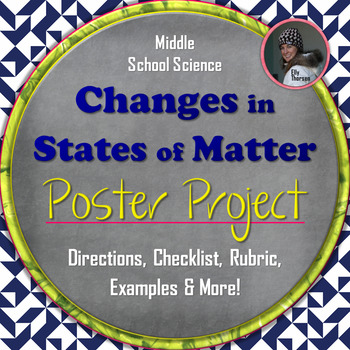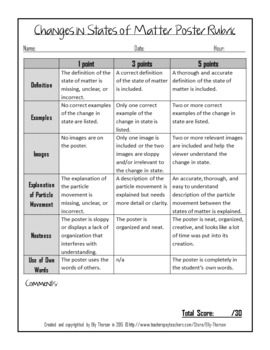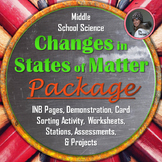Changes in States of Matter Poster Project Science Research Activity
- PDF
What educators are saying
Also included in
- Here's your changes in states of matter unit for your middle school science classroom! Melting, freezing, vaporization, condensation, and sublimation are the phase changes covered in this bundle. You will save yourself a ton of planning time while presenting your students with an interesting, cohesiPrice $30.00Original Price $41.75Save $11.75
Description
Use this science poster project with your upper elementary or middle school science students to learn about or reinforce the ideas of changes in states of matter, also called phase changes. Students choose one of the changes in states of matter (melting, freezing, vaporization, condensation, or sublimation). In their poster the students will need to include the definition of their change in state, examples, pictures, and a description of the particle movement.
What's included:
- Detailed directions and ideas for how to use this research activity in your classroom
- Thorough rubrics for detailed and consistent grading
- Poster requirements for students to reference
- Grading Sheets for a quick grading option or for peer review
- Student checklists to guide students in their project construction
- An optional blank poster template for project uniformity or for modification purposes
- Example posters to help students understand expectations
***This resource can also be purchased at a discount as a part of the Changes in States of Matter Package. The package comes with interactive notebook pages, this poster project, a comic project, stations, a card sorting activity, a BOOM Deck, worksheets, and an assessment. Follow the link above to purchase the package or get any of these resources individually.
Read what teachers are saying about this resource:
“The directions and rubric were very clear, and my students enjoyed creating their posters. I appreciate that you included examples...it was a time saver for me, since my students really benefit from seeing models of a finished product!”
“My student's loved creating their posters! I have them all on my walls for Open House!! It made the room look great!”
"Loved the rubric. It makes it easy to grade."
“The posters I received from students were absolutely impressive. The directions were simple for students to follow and the rubric was a superb tool to use with regard to accurate grading.”
Take a look at the many other Physical Science Resources in my store.
***Look for the green star near the top of any page in my store and click it to become a follower. As a follower of my store you will be notified when I upload a new resource.






